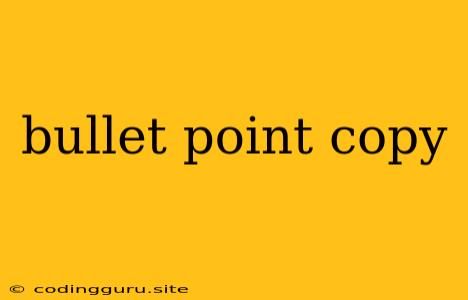Crafting Compelling Bullet Points: A Guide to Powerful Copywriting
Bullet points are a powerful tool in the world of copywriting. They break down complex information into easily digestible chunks, making your content more engaging and impactful. But crafting effective bullet points requires more than just a simple list. You need to consider the overall message you're trying to convey and use language that resonates with your audience.
Here's a breakdown of how to write bullet points that convert:
1. Start with a Strong Headline:
- What's the main takeaway you want your readers to grasp?
- Sum it up in a clear, concise headline that piques their interest.
- Your headline should be a mini-promise of the value they'll gain from reading your bullet points.
Example:
- Headline: Unlock the Secrets to Writing Killer Bullet Points
- Bullet Points:
- Use strong verbs to emphasize action.
- Focus on benefits, not features.
- Keep it short and sweet.
- Use numbers to highlight key points.
2. Keep it Concise:
- Each bullet point should be a single, focused idea.
- Avoid long, rambling sentences that overwhelm the reader.
- Strive for clarity and brevity.
Example:
- Instead of: "Our product helps you achieve better results through its advanced technology and user-friendly interface."
- Try: "Achieve better results with our user-friendly product featuring advanced technology."
3. Use Powerful Verbs:
- Strong verbs add punch and dynamism to your bullet points.
- They make your copy more active and engaging.
Example:
- Instead of: "Our product is reliable."
- Try: "Our product consistently delivers."
4. Focus on Benefits:
- Tell your readers what they will gain by using your product or service.
- Don't just list features, explain how those features translate into real-world value.
Example:
- Instead of: "Our software has a user-friendly interface."
- Try: "Enjoy a seamless user experience with our intuitive software."
5. Use Numbers:
- Numbers grab attention and provide a sense of structure.
- They help readers quickly scan and absorb the key points.
Example:
- Instead of: "Our product has many benefits."
- Try: "Our product offers 5 key benefits to your business."
6. Use Parallel Structure:
- Maintain a consistent grammatical structure for each bullet point.
- This creates a visual rhythm and makes your copy more readable.
Example:
- Instead of: "Our product is easy to use. It's also affordable. You can get it online."
- Try: "Our product is easy to use, affordable, and available online."
7. Use Visual Cues:
- Break up large chunks of text with bullets, subheadings, and white space.
- This improves readability and makes your content more inviting.
Example:
- Instead of: A long block of text with no formatting.
- Try: Using bullet points, subheadings, and whitespace to break up the text and make it easier to read.
8. Test and Refine:
- There's no one-size-fits-all approach to bullet point copywriting.
- Test different variations of your bullet points and see what performs best.
- Continuously analyze your data and make adjustments to optimize your copy.
Conclusion:
Crafting compelling bullet points is an essential skill for any copywriter. By focusing on clarity, brevity, and benefits, you can create content that resonates with your audience and drives conversions. Remember to experiment with different techniques and analyze your results to continuously refine your approach.
